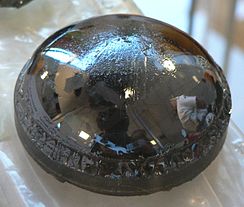
Back Silikonkarbied Afrikaans كربيد السيليكون Arabic Karborund Azerbaijani سیلیسیوم کاربید AZB Силициев карбид Bulgarian সিলিকন কার্বাইড Bengali/Bangla Carbur de silici Catalan Karbid křemíku Czech Карборунд CV Siliciumkarbid Danish
 A laboratory-grown synthetic SiC monocrystal
| |
| Names | |
|---|---|
| IUPAC name
Methanidylidynesilanylium
| |
| Preferred IUPAC name
Silicon carbide | |
| Other names
Carborundum
Moissanite | |
| Identifiers | |
3D model (JSmol)
|
|
| ChEBI | |
| ChemSpider | |
| ECHA InfoCard | 100.006.357 |
| EC Number |
|
| 13642 | |
| MeSH | Silicon+carbide |
PubChem CID
|
|
| RTECS number |
|
| UNII | |
CompTox Dashboard (EPA)
|
|
| |
| |
| Properties | |
| SiC | |
| Molar mass | 40.096 g/mol |
| Appearance | Yellow to green to bluish-black, iridescent crystals[1] |
| Density | 3.16 g⋅cm-3 (hex.)[2] |
| Melting point | 2,830 °C (5,130 °F; 3,100 K)[2] (decomposes) |
| Solubility | Insoluble in water, soluble in molten alkalis and molten iron[3] |
| Electron mobility | ~900 cm2/(V⋅s) (all polytypes) |
| −12.8 × 10−6 cm3/mol[4] | |
Refractive index (nD)
|
2.55 (infrared; all polytypes)[5] |
| Hazards | |
| GHS labelling:fibres[6] | |

| |
| Danger | |
| H350i | |
| P201, P202, P260, P261, P264, P270, P271, P280, P281, P302+P352, P304+P340, P305+P351+P338, P308+P313, P312, P314, P321, P332+P313, P337+P313, P362, P403+P233, P405, P501 | |
| NFPA 704 (fire diamond) | |
| NIOSH (US health exposure limits): | |
PEL (Permissible)
|
TWA 15 mg/m3 (total) TWA 5 mg/m3 (resp)[1] |
REL (Recommended)
|
TWA 10 mg/m3 (total) TWA 5 mg/m3 (resp)[1] |
IDLH (Immediate danger)
|
N.D.[1] |
Except where otherwise noted, data are given for materials in their standard state (at 25 °C [77 °F], 100 kPa).
| |
Silicon carbide (SiC), also known as carborundum (/ˌkɑːrbəˈrʌndəm/), is a hard chemical compound containing silicon and carbon. A wide bandgap semiconductor, it occurs in nature as the extremely rare mineral moissanite, but has been mass-produced as a powder and crystal since 1893 for use as an abrasive. Grains of silicon carbide can be bonded together by sintering to form very hard ceramics that are widely used in applications requiring high endurance, such as car brakes, car clutches and ceramic plates in bulletproof vests. Large single crystals of silicon carbide can be grown by the Lely method and they can be cut into gems known as synthetic moissanite.
Electronic applications of silicon carbide such as light-emitting diodes (LEDs) and detectors in early radios were first demonstrated around 1907. SiC is used in semiconductor electronics devices that operate at high temperatures or high voltages, or both.
- ^ a b c d NIOSH Pocket Guide to Chemical Hazards. "#0555". National Institute for Occupational Safety and Health (NIOSH).
- ^ a b Haynes, William M., ed. (2011). CRC Handbook of Chemistry and Physics (92nd ed.). Boca Raton, Florida: CRC Press. p. 4.88. ISBN 1-4398-5511-0.
- ^ Pubchem. "Silicon carbide". pubchem.ncbi.nlm.nih.gov. Retrieved 2018-11-27.
- ^ Haynes, William M., ed. (2011). CRC Handbook of Chemistry and Physics (92nd ed.). Boca Raton, Florida: CRC Press. p. 4.135. ISBN 1-4398-5511-0.
- ^ Cite error: The named reference
ioffewas invoked but never defined (see the help page). - ^ "C&L Inventory". echa.europa.eu. Retrieved 12 December 2021.
